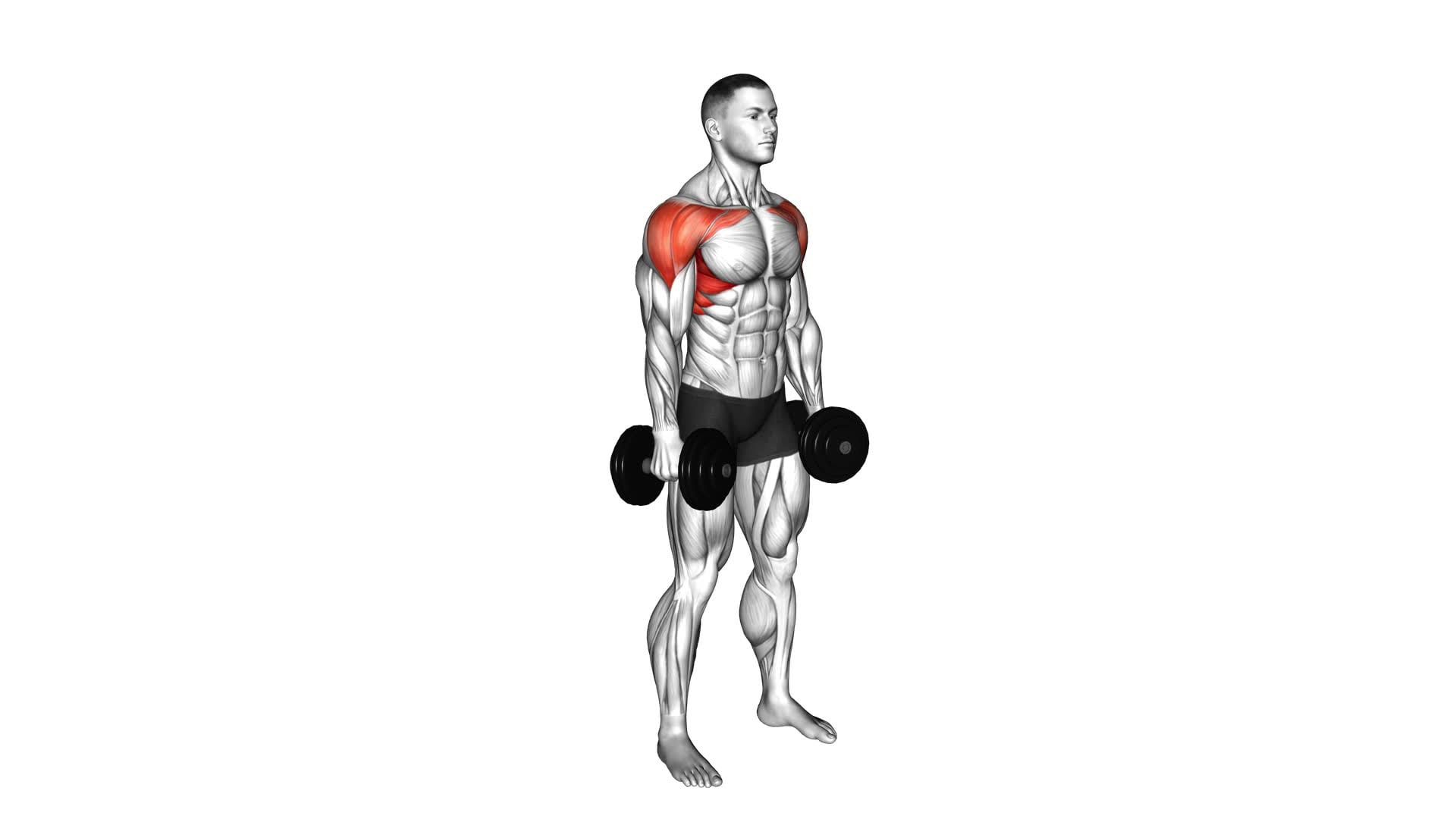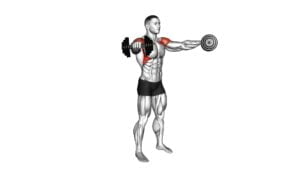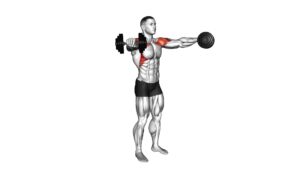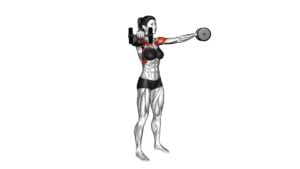Dumbbell Standing Front and Lateral Raise – Video Exercise Guide & Tips

Looking to strengthen your shoulders? Check out this video exercise guide for the Dumbbell Standing Front and Lateral Raise! In just a few minutes, you'll learn the proper form and technique for both front and lateral raises.
Watch This Exercise Video
Want to add more intensity to your workout? We've got variations for that too. Plus, discover essential tips to maximize your shoulder gains.
Get ready to sculpt and tone those muscles with this effective dumbbell exercise routine!
Key Takeaways
- Dumbbell standing front and lateral raises target and activate shoulder muscles.
- Proper form and technique in front raises can lead to increased shoulder strength and stability.
- Lateral raises help improve posture and upper body alignment.
- Adding variations such as drop sets and supersets can increase muscle activation and intensity in the raises.
Benefits of Dumbbell Standing Front and Lateral Raises
To maximize your shoulder strength and definition, performing dumbbell standing front and lateral raises offers numerous benefits. These exercises specifically target and activate the muscles in your shoulders, helping to build strength and definition. During dumbbell raises, the front raises primarily work the anterior deltoid, while the lateral raises target the lateral deltoid. This muscle activation helps to sculpt your shoulders and improve overall shoulder stability.
One of the great things about dumbbell standing front and lateral raises is that they can be modified to suit different fitness levels. If you're a beginner, you can start with lighter weights and gradually increase the weight as you get stronger. You can also perform the exercises seated instead of standing to reduce the demand on your core and maintain better form.
For those at an intermediate or advanced fitness level, you can challenge yourself by using heavier weights or incorporating variations such as Arnold presses or bent-over lateral raises. These modifications can help to further increase muscle activation and enhance the benefits of the exercise.
Remember, it's important to maintain proper form throughout the exercise to avoid injury and maximize results. Keep your core engaged, maintain a slight bend in your elbows, and avoid using momentum to lift the weights.
Proper Form and Technique for Front Raises
To perform front raises with proper form and technique, follow these steps:
- Stand with your feet shoulder-width apart and hold a dumbbell in each hand, palms facing your thighs.
- Keep your core engaged and your back straight throughout the exercise.
- Slowly lift the dumbbells in front of you, while maintaining a slight bend in your elbows, until they're parallel to the ground.
- Pause for a moment at the top of the movement, focusing on squeezing your shoulder muscles.
- Slowly lower the dumbbells back down to the starting position, controlling the movement.
- Repeat for the desired number of repetitions.
Proper form and technique in front raises provide several benefits:
- Increased shoulder strength and stability.
- Improved posture and upper body alignment.
- Enhanced muscle definition in the front and sides of the shoulders.
To maximize the effectiveness of front raises and avoid common mistakes, keep the following points in mind:
- Avoid using momentum to lift the dumbbells. Focus on controlled and deliberate movements.
- Don't raise the dumbbells above shoulder height to prevent strain on the rotator cuff.
- Maintain a neutral spine and avoid arching your back.
- Choose an appropriate weight that allows you to perform the exercise with proper form.
Proper Form and Technique for Lateral Raises
Now let's move on to the proper form and technique for lateral raises.
Lateral raises are a great exercise for targeting the deltoid muscles, specifically the middle and posterior heads.
To perform a lateral raise correctly, start by standing with your feet hip-width apart and holding a dumbbell in each hand, palms facing your body.
Keep a slight bend in your elbows throughout the exercise.
Next, raise your arms out to the sides until they're parallel to the floor, keeping your elbows slightly bent.
Make sure to maintain control and avoid swinging the weights or using momentum.
Remember to focus on squeezing your shoulder blades together as you lift the dumbbells to engage the correct muscles.
Common mistakes to avoid include lifting the dumbbells too high, which can put unnecessary strain on the shoulder joint, and using too much weight, which can compromise your form.
If you find that these mistakes are hindering your progress, try alternative exercises such as cable lateral raises or bent-over lateral raises to target the same muscle group.
Variations to Add Intensity to Your Raises
To increase the intensity of your raises, you can incorporate variations into your workout routine. Here are some advanced techniques that will help you maximize muscle activation and take your shoulder gains to the next level:
- Drop Sets: Perform your raises with a heavier weight until failure, then immediately switch to a lighter weight and continue until failure again. This technique exhausts your muscles and stimulates growth.
- Supersets: Combine your front and lateral raises into one superset. Start with front raises, then immediately transition to lateral raises without resting. This challenges your muscles in different ways and keeps them working continuously.
- Partial Reps: Instead of performing a full range of motion, focus on the most challenging part of the movement. For example, during lateral raises, only raise the dumbbells halfway up and then lower them back down. This targets specific muscle fibers and increases the intensity.
By incorporating these advanced techniques into your raises, you can push your muscles to their limits and achieve greater muscle activation.
Now, let's move on to essential tips for maximizing shoulder gains.
Transition Sentence: Now that you know how to add intensity to your raises, let's explore essential tips for maximizing shoulder gains.
Essential Tips for Maximizing Shoulder Gains
To maximize your shoulder gains, focus on proper form and technique during your dumbbell standing front and lateral raises. These exercises are excellent for shoulder stability and can help you build strong, well-defined shoulders.
To get the most out of your workouts, avoid common mistakes in shoulder exercises. One common mistake is using too much weight. It's important to start with a weight that allows you to maintain proper form throughout the exercise. Using too much weight can lead to poor form and increase the risk of injury.
Another mistake to avoid is swinging the weights. In order to target the shoulder muscles effectively, it's important to control the movement and avoid using momentum. Keep your movements slow and controlled, focusing on the muscles you're targeting.
Additionally, make sure to keep your core engaged and your spine neutral throughout the exercise. This will help you maintain stability and prevent strain on your lower back.
Frequently Asked Questions
How Many Sets and Reps Should I Do for Dumbbell Standing Front Raises and Lateral Raises?
To determine the number of sets and reps for dumbbell standing front raises and lateral raises, consider your fitness goals and current strength level.
Start with 2-3 sets of 10-12 reps for each exercise.
Focus on maintaining proper form throughout the movements. Keep your core engaged, shoulders relaxed, and lift the dumbbells in a controlled manner.
Gradually increase the weight or reps as you become more comfortable and stronger.
Can I Perform Front Raises and Lateral Raises on the Same Day?
Yes, you can perform front raises and lateral raises on the same day.
Doing both exercises together can provide a well-rounded shoulder workout.
Front raises target the anterior deltoids, while lateral raises focus on the lateral deltoids.
By incorporating both movements, you can effectively strengthen and tone your entire shoulder muscles.
It's important to vary the weights and reps to challenge your muscles and prevent plateaus.
Remember to maintain proper form and listen to your body's limits to avoid injury.
Is It Necessary to Warm up Before Performing Dumbbell Standing Front Raises and Lateral Raises?
Before performing dumbbell standing front raises and lateral raises, it's important to warm up. Warming up helps to increase blood flow to your muscles, improve flexibility, and reduce the risk of injury.
To properly execute these exercises, start with a light cardio warm-up, such as jogging or cycling, followed by dynamic stretches for your shoulders and arms. This will prepare your muscles and joints for the movements and ensure optimal performance.
Can I Use Resistance Bands Instead of Dumbbells for Front Raises and Lateral Raises?
Yes, you can definitely use resistance bands instead of dumbbells for front raises and lateral raises.
Resistance bands provide a different kind of resistance that can help strengthen your shoulder muscles.
They're also more portable and versatile, allowing you to perform exercises in different positions.
Using resistance bands for shoulder exercises can help improve stability and flexibility while targeting specific muscle groups.
Are There Any Common Mistakes to Avoid While Performing Dumbbell Standing Front Raises and Lateral Raises?
When performing dumbbell standing front raises and lateral raises, it's important to be aware of common mistakes and maintain proper form. Avoid swinging the weights or using momentum to lift them, as this can reduce the effectiveness of the exercise and increase the risk of injury.
Instead, focus on using controlled movements and engaging the targeted muscles. Keep your core engaged and maintain a slight bend in your elbows throughout the exercise for optimal results.
Conclusion
In conclusion, incorporating dumbbell standing front and lateral raises into your workout routine can provide numerous benefits for your shoulders. By using proper form and technique, you can effectively target the front and side deltoid muscles.
Additionally, adding variations to your raises can increase the intensity and challenge your muscles even more. Remember to follow these essential tips to maximize your shoulder gains and achieve optimal results.

Author
Years ago, the spark of my life’s passion ignited in my mind the moment I stepped into the local gym for the first time. The inaugural bead of perspiration, the initial endeavor, the very first surge of endorphins, and a sense of pride that washed over me post-workout marked the beginning of my deep-seated interest in strength sports, fitness, and sports nutrition. This very curiosity blossomed rapidly into a profound fascination, propelling me to earn a Master’s degree in Physical Education from the Academy of Physical Education in Krakow, followed by a Sports Manager diploma from the Jagiellonian University. My journey of growth led me to gain more specialized qualifications, such as being a certified personal trainer with a focus on sports dietetics, a lifeguard, and an instructor for wellness and corrective gymnastics. Theoretical knowledge paired seamlessly with practical experience, reinforcing my belief that the transformation of individuals under my guidance was also a reflection of my personal growth. This belief holds true even today. Each day, I strive to push the boundaries and explore new realms. These realms gently elevate me to greater heights. The unique combination of passion for my field and the continuous quest for growth fuels my drive to break new ground.







